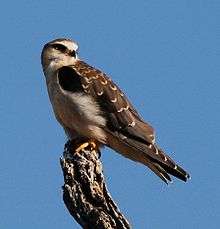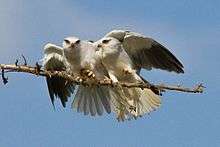Black-winged kite
| Black-winged kite | |
|---|---|
 | |
| E. c. vociferus | |
| Scientific classification | |
| Kingdom: | Animalia |
| Phylum: | Chordata |
| Class: | Aves |
| Order: | Accipitriformes |
| Family: | Accipitridae |
| Genus: | Elanus Savigny, 1809 |
| Species: | E. caeruleus |
| Binomial name | |
| Elanus caeruleus (Desfontaines, 1789) | |
| Subspecies | |
| |
| Synonyms | |
| |
The black-winged kite (Elanus caeruleus) is a small diurnal bird of prey in the family Accipitridae best known for its habit of hovering over open grasslands in the manner of the much smaller kestrels. This Eurasian and African species was sometimes combined with the Australian black-shouldered kite (Elanus axillaris) and the white-tailed kite (Elanus leucurus) of North and South America which together form a superspecies. This kite is distinctive, with long-wings, white, grey and black plumage and owl like forward-facing eyes with red irises. Although mainly seen on the plains, they are sometimes seen on grassy slopes of hills in the higher elevation regions of Asia. They are not migratory, but make short-distance movements in response to weather.
Description
This long-winged raptor is predominantly grey or white with black shoulder patches, wing tips and eye stripe. The long falcon-like wings extend beyond the tail when the bird is perched. In flight, the short and square tail is visible and it is not forked as in the typical kites of the genus Milvus. When perched, often on roadside wires, it often adjusts its wings and jerks its tail up and down as if to balance itself. The sexes are alike in plumage.[2] Their large forward-facing eyes and velvety plumage are characters that are shared with owls and the genus itself has been considered as a basal group within the Accipitridae.[3]
Distribution and habitat
_in_Hyderabad_W_IMG_4418.jpg)
The black-winged kite is a species primarily of open land and semi-deserts in sub-Saharan Africa and tropical Asia, but it has a foothold within Europe in Spain and Portugal. The species range appears to be expanding in southern Europe and possibly in West Asia.[4][5][6]
Several geographic populations have been named as subspecies and these include the nominate subspecies which occurs in Spain, Africa and Arabia. The subspecies vociferus is found east of this range across South Asia and into Southeast Asia. Along Sumatra, Java, Borneo and the Philippines subspecies hypoleucus (sometimes considered a full species) is found while wahgiensis is restricted to New Guinea. Subspecies sumatranus is not always recognized. The white-tailed kite and the black-shouldered kite were formerly included with this species but have since been treated as separate species.[7][8]
Although found mainly on the plains they have been seen at higher altitudes in Sikkim (3,650 m (11,980 ft)),[9] the Nilgiris (Doddabetta, 2,670 m (8,760 ft))[10] and Nagaland (2,020 m (6,630 ft)).[11]
They are said to be winter visitors in some parts of their range such as the Western Ghats.[2]
Behaviour and ecology

The black-winged kite breeds at different times of the year across its range. Although nesting has been noted throughout the year in India, they appear not to breed in April and May. Courtship is noisy and involves chases and once the pair is formed they copulate frequently.[12] The nest is a loose platform of twigs in which 3 or 4 eggs are laid. The female spends more effort in the construction of the nest than the male. The eggs are pale creamy with spots of deep red. Both parents incubate but when the chicks hatch, the male spends more time on foraging for food.[2] Females initially feed the young, sometimes hunting close to the nest but will also receive food from the male. After fledging the young birds continue to be dependent for food on the male parent for about 80 days, initially transferring food at perch and later in the air.[13]
Their prey includes grasshoppers, crickets and other large insects, lizards and rodents. Injured birds, small snakes and frogs have also been reported.[2] The black-winged kite flies slowly during hunting like a harrier, but it will also hover like a Kestrel. It has on rare occasions been known to hunt prey in flight.[14] Perches are used for hunting and for feeding but large prey may sometimes be handled on the ground.[15] In southern Africa, they appear to favour roadside verges for foraging and are sometimes killed by collisions with vehicles.[16]
These birds roost communally with groups of 15 to 35 (larger numbers in Europe[17]) converging at a large leafy tree.[18] They are extremely silent and the calls recorded include a high-pitched squeal or a soft whistle.[2] They call mainly during the breeding season.[19][20]

A species of nematode, Physaloptera acuticauda, has been recorded as a parasite of the species in South Africa.[21]
References
- ↑ BirdLife International (2013). "Elanus caeruleus". IUCN Red List of Threatened Species. Version 2013.2. International Union for Conservation of Nature. Retrieved 26 November 2013.
- 1 2 3 4 5 Ali, S.; Ripley, S.D. (1978). Handbook of the birds of India and Pakistan. 1 (2nd ed.). Oxford University Press. pp. 212–214. ISBN 0-19-562063-1.
- ↑ Negro, Juan J.; Pertoldi, Cino; Randi, Ettore; Ferrero, Juan J.; López-Caballero, José M.; Rivera, Domingo; Korpimäki, Erkki (2006). "Convergent evolution of Elanus kites and the owls". Journal of Raptor Research. 40 (3): 222–225. doi:10.3356/0892-1016(2006)40[222:CEOEKA]2.0.CO;2.
- ↑ Balbontin, J.; Negro, J.J.; Sarasola, N.H.; Ferrero, J.J.; Rivera, D. (2008). "Land-use changes may explain the recent range expansion of the Black-shouldered Kite Elanus caeruleus in southern Europe". Ibis. 150 (4): 707–716. doi:10.1111/j.1474-919X.2008.00845.x.
- ↑ Salim, M.A. (2002). "The first records, including breeding, of Black-winged Kite Elanus caeruleus in Iraq". Sandgrouse. 24 (2): 136–137.
- ↑ Sehatisabet, M.E.; Musavi, S.B.; Bakhtiari, P.; Moghaddas, D.; Hamidi, N.; Nezami, B.; Khaleghizadeh, A. (2006). "Further significant extensions of migrant distribution and breeding and wintering ranges in Iran for over sixty species". Sandgrouse. 28 (2): 146–155.
- ↑ Clark, W.S.; Banks, R.C. (1992). "The taxonomic status of the White-tailed Kite" (PDF). Wilson Bulletin. 104 (4): 571–579.
- ↑ Hussain, K.Z. (1959). "Notes on the taxonomy and zoogeography of the genus Elanus" (PDF). Condor. 61 (2): 153–154. doi:10.2307/1365216.
- ↑ Ganguli-Lachungpa, Usha (1990). "Blackwinged Kite Elanus caeruleus vociferus (Latham) at 3650 m in Sikkim". Journal of the Bombay Natural History Society. 87 (1): 142.
- ↑ Krishna, M.B. (1979). "The range of the Blackwinged Kite". Newsletter for Birdwatchers. 19 (7): 10.
- ↑ Choudhury, A. (1996). "New elevation record for Black-winged Kite from Nagaland". Newsletter for Birdwatchers. 36 (5): 96.
- ↑ Ferrero, J.J.; Grande, J.M.; Negro, J.J. (2003). "Copulation behavior of a potentially double-brooded bird of prey, the Black-winged Kite (Elanus caeruleus)" (PDF). Journal of Raptor Research. 37 (1): 1–7.
- ↑ Bustamante, J. (1993). "The post-fledging dependence period of the Black-shouldered Kite (Elanus caeruleus)" (PDF). Journal of Raptor Research. 27 (4): 185–190.
- ↑ Lamba, B.S. (1969). "Blackwinged Kite, Elanus caeruleus vociferus (Latham) taking in flight a wounded Green Pigeon, Treron phoenicoptera (Latham)". Journal of the Bombay Natural History Society. 66 (3): 622.
- ↑ Tarboton, W.R. (1978). "Hunting and the Energy Budget of the Black-Shouldered Kite". The Condor. 80 (1): 88–91. doi:10.2307/1367793. JSTOR 1367793.
- ↑ Dean, W.R.J.; Milton, S.J. (2003). "The importance of roads and road verges for raptors and crows in the Succulent and Nama-Karoo, South Africa". Ostrich. 74 (3&4): 181–186. doi:10.2989/00306520309485391.
- ↑ Parejo, D.; Avilés, J.M.; Ferrero, J.J.; Rivera, D. (2001). "Communal roosting and diet of Black-shouldered Kite Elanus caeruleus wintering in the southwest of Spain" (PDF). Journal of Raptor Research. 35: 162–164.
- ↑ Bharos, A.M.K. (1997). "A large communal roost of Blackwinged Kites Elanus caeruleus". Journal of the Bombay Natural History Society. 94 (3): 566.
- ↑ Sharma, A.K. (1993). "Courtship display of Blackwinged Kite". Newsletter for Birdwatchers. 33 (3): 54.
- ↑ Srinivas, V. (2002). "A large congregation of black-shouldered kite Elanus caeruleus at Ranthambore National Park". Journal of the Bombay Natural History Society. 99 (2): 297.
- ↑ Ransom, B.H. (1904). Manson's eye worm of chickens. USDA, Washington. p. 42.
Other sources
- Hume, A.O. (1872). "On the breeding of Elanus Melanopterus". Stray Feathers. 1 (1): 21–26.
- Hodgson, B.H. (1837). "On the structure and habits of the Elanus melanopterus". Madras Journal of Literature and Science. 6: 75–78.
- Goriup, P.D. (1981). "Observations on a pair of Black-winged Kites (Elanus cueruleus) in eastern Portugal". Arquivos Museu Bocage. B. 1: 65–79.
- Naoroji, Rishad (1986). "Communal gathering of Blackwinged Kites (Elanus caeruleus vociferus)". Journal of the Bombay Natural History Society. 83 (Supp): 200–201.
- Harris, T.; Walters, C. (1982). "Chromosomal sexing of the Black Shouldered Kite (Elanus caeruleus) (Aves: Accipitridae)". Genetica. 60 (1): 19–20. doi:10.1007/BF00121451.
External links
| Wikimedia Commons has media related to Elanus caeruleus. |
| Wikispecies has information related to: Elanus caeruleus |
- (Black-winged Kite or ) Black-shouldered Kite species text in The Atlas of Southern African Birds
- "Common Black-shouldered Kite media". Internet Bird Collection.
- Ageing and sexing (PDF; 0.95 MB) by Javier Blasco-Zumeta & Gerd-Michael Heinze
- Black-shouldered Kite photo gallery at VIREO (Drexel University)
- Interactive range map of Elanus caeruleus at IUCN Red List maps
- Original species description by Desfontaines (in French, 1787), with illustration pl. 15
- Illustrations, plate 36 and pl. 37, with description in French by Levaillant (1799).
